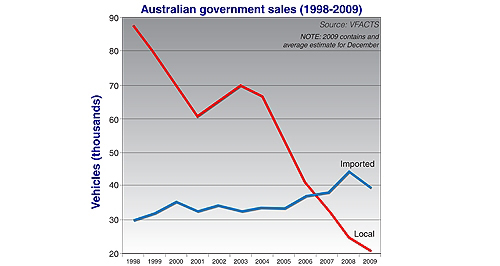Make / Model Search
News - General NewsGovernments think local, often buy importedWhite hope: The Camry Hybrid will provide an opportunity for governments to reverse the trend to imported cars. Local car slide not helped by government shift to imported vehicles15 Dec 2009 AUSTRALIAN governments bought more than 87,000 Australian-made cars in 1998. The corresponding number for this year is set to be fewer than 21,000. The VFACTS figures provide a staggering example of the kind of challenge local manufacturers are facing. Government purchases of imported vehicles have increased steadily (apart from a dip this year) from 2004 and exceeded local sales for the first time in 2007. The figure went from more than 30,000 in 1998 to an expected final tally of 39,000 for this year. While import sales have risen, total government purchases are still well below where they stood in 1998. Two reasons appear to stand out for this decline. The first is the reduction in public servants which follows the cuts in staff levels in general as well as the privatisation of many formerly public operations – Telstra being a prime example. These sales previously would have been counted as government sales and now are classified as business sales. The other relates to a process that saw governments buy cars at a low fleet prices, use them only for a short period before selling them for not much less than what they bought them for. Some car company executives claim some were even sold at a profit. This did wonders for the production volumes of the local car-makers, but didn’t generate much income and could also have hurt resale values.  Left: Federal industry minister Kim Carr. Left: Federal industry minister Kim Carr.That helps explain the general decline in government purchases, but why are governments buying more imported models?One is a decline in local four-cylinder car production, with the demise of vehicles such as the local Toyota Corolla and Ford Laser, which has closed a door to small-car sales opportunity in this era of "four-cylinder only" policy. But many local and state governments seem to feel little pressure to buy Australian when the factories are located interstate. The Queensland’s government’s recent no six-cylinder purchasing policy is a great example. It instantly excluded locally produced Ford, Holden and Toyota cars (only the Camry is still eligible) all of whom are located in Victoria and South Australia. Could you imagine this ban being put in place back when Ford and Holden were producing vehicles in Queensland? Either can I. Much of the reasoning given for government’s buying fewer Australian cars is that they are not sufficient green. This concern, and an on-radio challenge from a Greens member, was behind Kevin Rudd dumping his locally-made Territory for a Toyota Prius in the lead-up to the 2007 election. But this is all about to change. Governments will be able to buy an Australian-made Camry Hybrid from next February. They will also be able to buy an economical, and presumably fairly cheap, locally-made Holden Cruze small car from later next year. In 2011, four-cylinder Falcons will also be on the market. This is all music to the ears of federal industry minister Senator Kim Carr, who unashamedly drives a Territory. Senator Carr is well aware of the drop in government purchases and has appointed advocates to meet with various federal, state and local governments to try to encourage them to buy Australian. “You can’t make people buy Australian, but you can explain to them the benefits of buying Australian,” Senator Carr told GoAuto earlier this year. “We have to match capability with opportunity. “In the Army for instance, why do you need to buy a Kluger when the (locally made) Territory is there? You can argue that case out on price, whole of life costings, performance and appropriate use.”  |
Click to shareGeneral News articlesResearch General News Motor industry news |









Facebook Twitter Instagram